pegaz666
10 µW
Hello,
Hopefully someone can help me out here. I know these pcb spot welderers are junk but after beefing up all the traces, making my own AWG 4 cables and electrodes and using a separate power source (small 3s battery) just to power up the electronics while using originally 5s 4500mah 40C lipo (charged to storage= 19V) as a welding source (positive avoids going through the board and goes directly to welding tip while negative goes through the mosfets on PCB). It’s got 7 gears where each one of them represents a 10ms short increase. So 1=10ms, 2=20ms and so on. I had to use it on level 7=70ms.
It was doing quite well for a while - i’ve done 600shots through 0.1mm pure copper and 0.15mm pure nickel sandwich just fine. Although my lipo was getting hot and eventually died at around 400 shots (internal lipo tab burned off) i was able to remove the cell and convert this 5s lipo into 4s lipo but this time i had to use it fully charged at 16.8V or something.
I keept continuing like that until it burned the inner tab again and fry all the mosfets + mosfet that was controlling all gates… I have bought an exact replacement mosfets IPLU300N04S4-R7 from china again (probably fake hence the failure?) as well as that little mosfet that controls gates. Since I couldn’t fix my battery again i have bought a brand new 4S 10.000mah 100c continuous (200C peak) CNHL lipo. I’ve charged it to storage and used it with my welder on level 3/4 now so 30-40ms. The welds were looking great, lipo was cold, i was making 30sec stops before each weld. Out of sudden after 25 shots it blew up again: new battery , all mosfets and mosfet for gates! I don’t know what happened and why this time it lasted so short??? Did mosfet fail and made all other mosfets to fail and longer than 70ms pulse broke the internal lipo tab again? Or it was the battery being too strong that triggered all of that disaster???
, all mosfets and mosfet for gates! I don’t know what happened and why this time it lasted so short??? Did mosfet fail and made all other mosfets to fail and longer than 70ms pulse broke the internal lipo tab again? Or it was the battery being too strong that triggered all of that disaster???
This time I don’t want to risk buying knock-off mosfets from China instead I will get them from Mouser:
I was thinking about original replacement: IPLU300N04S4-R8 OR maybe instead it would be better to put the same ones used in kWeld: FDB0105N407L since they seem “stronger”?
Don’t know which ones I should go for - not a specIalist with all these parameters (both data-sheets attached).
Since this time the cost of the components is significant I wanted to protect mosfet gates somehow (kWeld also got some zener diode and resistor near each mosfet). If one mosfet will fail and gate gets shorted at least it won’t kill all other mosfets. I believe this is what its for…
COULD SOMEONE PLEASE suggest what to put in line with each mosfet gate? I have drawn some diagram to show how it looks on my welder and attach some pictures from oscilloscope to show how pulses look like on this spot welder. Many tanks in advance!
@tatus1969 - maybe You could give me some advice how to stop blowing all mosfets at once? Thank you!
Hopefully someone can help me out here. I know these pcb spot welderers are junk but after beefing up all the traces, making my own AWG 4 cables and electrodes and using a separate power source (small 3s battery) just to power up the electronics while using originally 5s 4500mah 40C lipo (charged to storage= 19V) as a welding source (positive avoids going through the board and goes directly to welding tip while negative goes through the mosfets on PCB). It’s got 7 gears where each one of them represents a 10ms short increase. So 1=10ms, 2=20ms and so on. I had to use it on level 7=70ms.
It was doing quite well for a while - i’ve done 600shots through 0.1mm pure copper and 0.15mm pure nickel sandwich just fine. Although my lipo was getting hot and eventually died at around 400 shots (internal lipo tab burned off) i was able to remove the cell and convert this 5s lipo into 4s lipo but this time i had to use it fully charged at 16.8V or something.
I keept continuing like that until it burned the inner tab again and fry all the mosfets + mosfet that was controlling all gates… I have bought an exact replacement mosfets IPLU300N04S4-R7 from china again (probably fake hence the failure?) as well as that little mosfet that controls gates. Since I couldn’t fix my battery again i have bought a brand new 4S 10.000mah 100c continuous (200C peak) CNHL lipo. I’ve charged it to storage and used it with my welder on level 3/4 now so 30-40ms. The welds were looking great, lipo was cold, i was making 30sec stops before each weld. Out of sudden after 25 shots it blew up again: new battery
This time I don’t want to risk buying knock-off mosfets from China instead I will get them from Mouser:
I was thinking about original replacement: IPLU300N04S4-R8 OR maybe instead it would be better to put the same ones used in kWeld: FDB0105N407L since they seem “stronger”?
Don’t know which ones I should go for - not a specIalist with all these parameters (both data-sheets attached).
Since this time the cost of the components is significant I wanted to protect mosfet gates somehow (kWeld also got some zener diode and resistor near each mosfet). If one mosfet will fail and gate gets shorted at least it won’t kill all other mosfets. I believe this is what its for…
COULD SOMEONE PLEASE suggest what to put in line with each mosfet gate? I have drawn some diagram to show how it looks on my welder and attach some pictures from oscilloscope to show how pulses look like on this spot welder. Many tanks in advance!
@tatus1969 - maybe You could give me some advice how to stop blowing all mosfets at once? Thank you!
Attachments
-
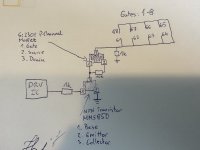 449B36B3-382C-4A57-998B-3CEDB6D9E430.jpeg1.8 MB · Views: 10
449B36B3-382C-4A57-998B-3CEDB6D9E430.jpeg1.8 MB · Views: 10 -
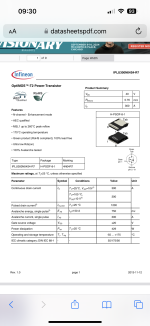 EA958D38-5353-4429-8C1A-F3D10386635A.png1.6 MB · Views: 7
EA958D38-5353-4429-8C1A-F3D10386635A.png1.6 MB · Views: 7 -
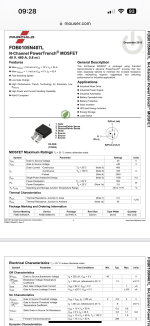 318D0885-48B1-4BA7-B675-13A3EE866B12.png807.6 KB · Views: 7
318D0885-48B1-4BA7-B675-13A3EE866B12.png807.6 KB · Views: 7 -
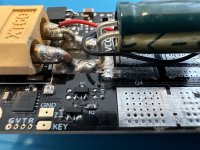 2BA4973D-97E6-4CC1-9182-6F0BDAF8E20B.jpeg2.3 MB · Views: 9
2BA4973D-97E6-4CC1-9182-6F0BDAF8E20B.jpeg2.3 MB · Views: 9 -
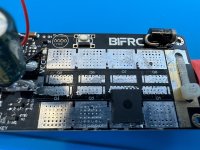 CD3BF110-FD98-46D1-87A3-E795DA2589A2.jpeg2.6 MB · Views: 8
CD3BF110-FD98-46D1-87A3-E795DA2589A2.jpeg2.6 MB · Views: 8 -
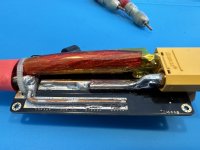 5AC55288-9C4A-4250-8A66-D68128A51D0B.jpeg2 MB · Views: 8
5AC55288-9C4A-4250-8A66-D68128A51D0B.jpeg2 MB · Views: 8 -
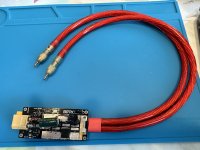 194A4111-A623-468D-80AF-08A376AA39D9.jpeg1.8 MB · Views: 6
194A4111-A623-468D-80AF-08A376AA39D9.jpeg1.8 MB · Views: 6 -
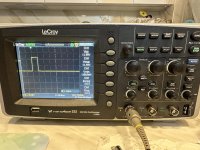 BDE17C7D-284B-4048-A92F-1049999F2842.jpeg2.7 MB · Views: 8
BDE17C7D-284B-4048-A92F-1049999F2842.jpeg2.7 MB · Views: 8 -
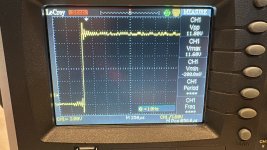 6AF403FE-6991-465A-8E52-9525A948C712.jpeg771.9 KB · Views: 12
6AF403FE-6991-465A-8E52-9525A948C712.jpeg771.9 KB · Views: 12
Last edited:

